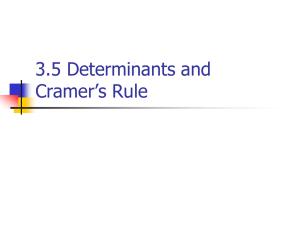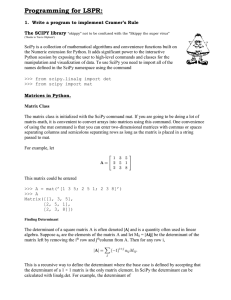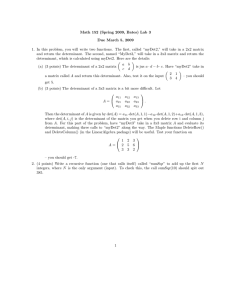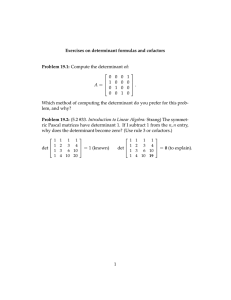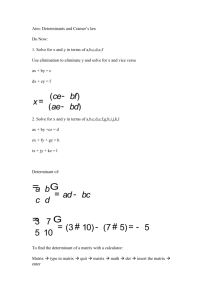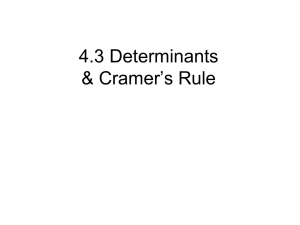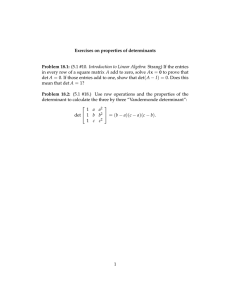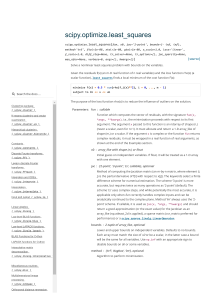Programming Least Squares.doc
advertisement
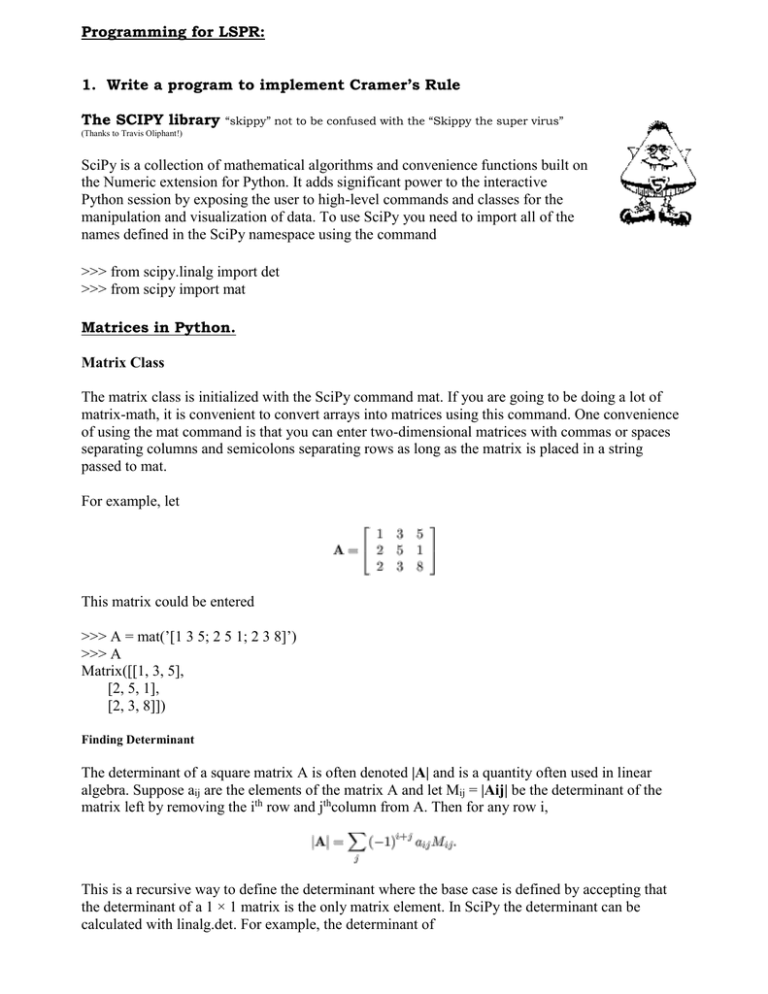
Programming for LSPR: 1. Write a program to implement Cramer’s Rule The SCIPY library “skippy” not to be confused with the “Skippy the super virus” (Thanks to Travis Oliphant!) SciPy is a collection of mathematical algorithms and convenience functions built on the Numeric extension for Python. It adds significant power to the interactive Python session by exposing the user to high-level commands and classes for the manipulation and visualization of data. To use SciPy you need to import all of the names defined in the SciPy namespace using the command >>> from scipy.linalg import det >>> from scipy import mat Matrices in Python. Matrix Class The matrix class is initialized with the SciPy command mat. If you are going to be doing a lot of matrix-math, it is convenient to convert arrays into matrices using this command. One convenience of using the mat command is that you can enter two-dimensional matrices with commas or spaces separating columns and semicolons separating rows as long as the matrix is placed in a string passed to mat. For example, let This matrix could be entered >>> A = mat(’[1 3 5; 2 5 1; 2 3 8]’) >>> A Matrix([[1, 3, 5], [2, 5, 1], [2, 3, 8]]) Finding Determinant The determinant of a square matrix A is often denoted |A| and is a quantity often used in linear algebra. Suppose aij are the elements of the matrix A and let Mij = |Aij| be the determinant of the matrix left by removing the ith row and jthcolumn from A. Then for any row i, This is a recursive way to define the determinant where the base case is defined by accepting that the determinant of a 1 × 1 matrix is the only matrix element. In SciPy the determinant can be calculated with linalg.det. For example, the determinant of is In SciPy this is computed as shown in this example: >>> A = mat(’[1 3 5; 2 5 1; 2 3 8]’) >>> linalg.det(A) -25.000000000000004 Alternately, you can define the matrix as follows: >>> equation1='2,1,1;' >>> equation2='1,-1,-1;' >>> equation3='1,2,1' >>> A=mat(equation1+equation2+equation3) >>> print A [[ 2 1 1] [ 1 -1 -1] [ 1 2 1]] >>> print det(A) 3.0 Of finally we could define it as we have all along as a list of lists: >>> equation1=[2,1,1] >>> equation2=[1,-1,-1] >>> equation3=[1,2,1] >>> A = [equation1,equation2,equation3] >>> print A [[2, 1, 1], [1, -1, -1], [1, 2, 1]] >>> print det(A) 3.0 Exercise: Write a function that takes as input a matrix of coefficients and calculates the values of x,y and z that satisfy the three equations using Cramer’s rule. Here is the sample data we have been using: 2x + y + z = 3 x– y–z=0 x + 2y + z = 0 And we recall from class that the solutions are: x = 1, y = –2, and z = 3 Recall that in step 7 of LSPR, you have to solve a system of linear equations that look like this: – x = ax + by + c – y = dx + ey + f Your programming task for the remainder of the period is to write a program that can find the solution via least squares to the following equations. 7x1 3x1 2x1 4x1 9x1 – + – + - 6x2 5x2 2x2 2x2 8x2 + + – + 8x3 2x3 7x3 5x3 7x3 – – – – – 15 27 20 2 5 = = = = = 0 0 0 0 0 First solve it by hand: 7x1 3x1 2x1 4x1 9x1 -108 – + – + - 6x2 5x2 2x2 2x2 8x2 -69 + + + – + 8x3 2x3 7x3 5x3 7x3 -71 – – – – – 15 27 20 2 5 = = = = = 0 0 0 0 0 -6 -21 -13 -1 3 Add the rows s1, s2, s3, s4,s5 ∑ai1si, ∑ai2si, ∑ai3si, Setup the normal equations: A11 = ∑ai12 A12 = ∑ai1ai2 A22 = ∑ai22 A13 = ∑ai1ai32 B1 = ∑ai1bi A23 = ∑ai2ai32 B2 = ∑ai2bi A33 = ∑ai32 B3 = ∑ai3bi 159x1 – 95x2 + 107x3 – 279 = 0 -95x1 + 133x2 – 138x3 + 31 = 0 107x1 – 138x2 + 191x3 – 231 = 0 Use Cramer’s Rule to solve: x1 = 2.474 x2 = 5.397 x3 = 3.723 If you have time, have your program calculate the residuals for each of the original equations and the standard deviation of the residuals. residuals [-0.28110831 -0.04074867 0.21272028 0.07598631 0.15117982] Standard Deviation 0.0527843650619 Now generalize your program as function so that you can pass it a set of three parameters , x and y values and it will correctly calculate the associated a,b and c values. If you have time, come up with a visual representation of your fit and the data. .
